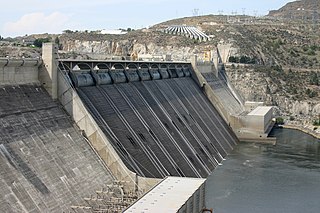
Public works are a broad category of infrastructure projects, financed and procured by a government body for recreational, employment, and health and safety uses in the greater community. They include public buildings, transport infrastructure, public spaces, public services, environmental protection and other, usually long-term, physical assets and facilities. Though often interchangeable with public infrastructure and public capital, public works does not necessarily carry an economic component, thereby being a broader term. Construction may be undertaken either by directly employed labour or by a private operator.
Getlink, formerly Groupe Eurotunnel, is a European public company based in Paris that manages and operates the infrastructure of the Channel Tunnel between France and the United Kingdom, operates the LeShuttle railway service, and earns revenue on other trains that operate through the tunnel.

A public–private partnership is a long-term arrangement between a government and private sector institutions. Typically, it involves private capital financing government projects and services up-front, and then drawing revenues from taxpayers and/or users for profit over the course of the PPP contract. Public–private partnerships have been implemented in multiple countries and are primarily used for infrastructure projects. Although they are not compulsory, PPPs have been employed for building, equipping, operating and maintaining schools, hospitals, transport systems, and water and sewerage systems.
Build–operate–transfer (BOT) or build–own–operate–transfer (BOOT) is a form of project delivery method, usually for large-scale infrastructure projects, wherein a private entity receives a concession from the public sector to finance, design, construct, own, and operate a facility stated in the concession contract. The private entity will have the right to operate it for a set period of time. This enables the project proponent to recover its investment and operating and maintenance expenses in the project.

The planning fallacy is a phenomenon in which predictions about how much time will be needed to complete a future task display an optimism bias and underestimate the time needed. This phenomenon sometimes occurs regardless of the individual's knowledge that past tasks of a similar nature have taken longer to complete than generally planned. The bias affects predictions only about one's own tasks. On the other hand, when outside observers predict task completion times, they tend to exhibit a pessimistic bias, overestimating the time needed. The planning fallacy involves estimates of task completion times more optimistic than those encountered in similar projects in the past.
Project governance is the management framework within which project decisions are made. Project governance is a critical element of any project since the accountabilities and responsibilities associated with an organization's business as usual activities are laid down in its organizational governance arrangements; seldom does an equivalent framework exist to govern the development of its capital investments (projects). For instance, the organization chart provides a good indication of who in the organization is responsible for any particular operational activity the organization conducts. But unless an organization has specifically developed a project governance policy, no such chart is likely to exist for project development activity.
A cost estimate is the approximation of the cost of a program, project, or operation. The cost estimate is the product of the cost estimating process. The cost estimate has a single total value and may have identifiable component values.

Rationality and Power: Democracy in Practice is a 1998 book by Bent Flyvbjerg, published by the University of Chicago Press. The book focuses on "the application of critical theory to urban and community development". Flyvbjerg here deploys the methodology for doing social science, which he developed in Making Social Science Matter (2001).

A megaproject is an extremely large-scale construction and investment project. A more general definition is "Megaprojects are temporary endeavours characterised by: large investment commitment, vast complexity, and long-lasting impact on the economy, the environment, and society".
A cost overrun, also known as a cost increase or budget overrun, involves unexpected incurred costs. When these costs are in excess of budgeted amounts due to a value engineering underestimation of the actual cost during budgeting, they are known by these terms.
Bent Flyvbjerg is a Danish economic geographer. He is the Villum Kann Rasmussen Professor at the IT University of Copenhagen.

Brittle Power: Energy Strategy for National Security is a 1982 book by Amory B. Lovins and L. Hunter Lovins, prepared originally as a Pentagon study and re-released in 2001 following the September 11 attacks. The book argues that the U.S. domestic energy infrastructure is very vulnerable to disruption, whether by accident or malice, often even more so than US technology is vulnerable to disruption of the imported oil supply. According to the authors, a resilient energy system is feasible, costs less, works better, and is favoured in the market, but is rejected by U.S. policy. In the preface to the 2001 edition, Lovins explains that these themes are still very current.
Reference class forecasting or comparison class forecasting is a method of predicting the future by looking at similar past situations and their outcomes. The theories behind reference class forecasting were developed by Daniel Kahneman and Amos Tversky. The theoretical work helped Kahneman win the Nobel Prize in Economics.
Andy Pasztor is a former journalist with The Wall Street Journal. He is the author of the 1995 book When the Pentagon was for Sale: Inside America's Biggest Defense Scandal. Pasztor also appeared in the 2022 documentary film Downfall: The Case Against Boeing, which examined Boeing's role in two fatal crashes of the Boeing 737 MAX: Lion Air Flight 610 and Ethiopian Airlines Flight 302.
Project assurance or programme assurance is a discipline that seeks to provide an independent and objective oversight of the likely future performance of major projects for those responsible for sanctioning, financing or insuring such undertakings. The discipline has emerged as a response to consistent problems in major projects and the need to provide confidence for project or programme stakeholders of technologically advanced, high capital or high risk projects.

Infrastructure asset management is the integrated, multidisciplinary set of strategies in sustaining public infrastructure assets such as water treatment facilities, sewer lines, roads, utility grids, bridges, and railways. Generally, the process focuses on the later stages of a facility's life cycle, specifically maintenance, rehabilitation, and replacement. Asset management specifically uses software tools to organize and implement these strategies with the fundamental goal to preserve and extend the service life of long-term infrastructure assets which are vital underlying components in maintaining the quality of life in society and efficiency in the economy. In the 21st century, climate change adaptation has become an important part of infrastructure asset management competence.

Making Social Science Matter: Why Social Inquiry Fails and How It Can Succeed Again is a 2001 book by Bent Flyvbjerg, published by Cambridge University Press. The author is critical of social sciences to the extent they try to emulate natural science. First, he argues that social sciences have failed as science, that is, in producing predictive theory. Second, he develops an argument that in order to matter again, social sciences must model themselves after phronesis. Finally, he develops methodological guidelines and shows practical examples of how a phronetic social science may be employed for research purposes.
The hiding hand principle is a theory that offers a framework to examine how ignorance intersects with rational choice to undertake a project; the intersection is seen to provoke creative success over the obstacles through the deduction that it is too late to abandon the project. The term was coined by economist Albert O. Hirschman.
Lavagnon Ika is a Benin-born, Canadian project management scientist, academic, thought leader, and author. He is professor of Project Management, the founding director of the Major Projects Observatory, as well as the program director of the MSc in Management at the Telfer School of Management at the University of Ottawa, and an Extraordinary Professor at the University of Pretoria.








